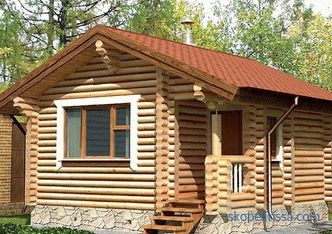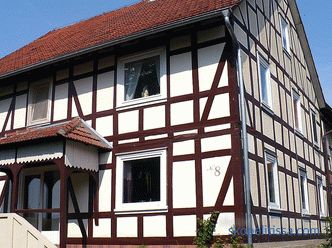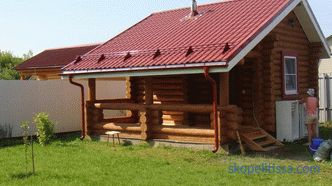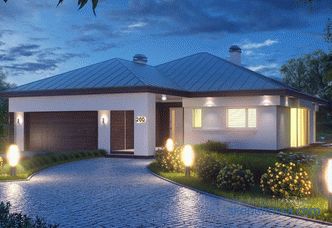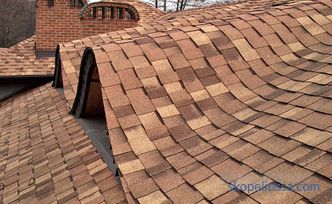Modern materials and technologies allow for the insulation of facade walls in various ways. The article describes the functions, benefits and technologies of insulation. You will get acquainted with the popular insulation materials, learn how their advantages and disadvantages affect the insulation of the facade of the house outside, the final price of the works.

Functions and benefits of facade insulation
The insulation of the facade of a country house has long become an indispensable stage of construction that improves the quality of life; external insulation is designed to perform the following functions:
-
Reducing heat transfer . It maintains a microclimate in the dwelling, due to which the dwelling is kept warm in the winter and cool in the summer.
-
Improving the appearance of the house . Over insulation is performed, playing a decorative role.
-
Extending the life of the home . The construction of insulation and finishing protects the facade walls from natural influences, prevents the penetration of moisture and mold development.
External insulation of facade walls allows you to enjoy the following benefits:
-
The comfort of living increases without reducing the area of residential premises.
-
Noise insulation is improved.
-
You can update the appearance of the building to your liking.
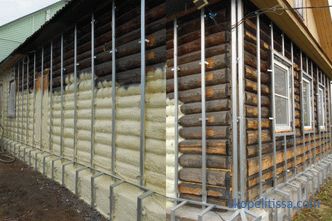
-
Costs associated with weatherization, will begin to pay off during the heating season. Heat losses can be reduced by 30-40%, which will reduce the costs associated with heating.
Facade thermal insulation technologies
Several methods of thermal insulation are in demand in suburban housing construction:
-
Ventilated facade technology . Easy to perform, cheap and popular option. It provides for mounting of the hinged frame, wooden or metal, between the guides of which a warming layer is placed (with fastening of the wind-proof membrane). The gap remaining between the insulation and lining provides free air circulation and removal of excess moisture. The facing layer is chosen at the discretion of the owners. The market offers a variety of materials, including siding, professional sheet, composite and fiber cement panels.
-
With the use of thermopanels . A simple and aesthetic way to warm the house; the material has good performance properties, frost resistance and effective thermal insulation.
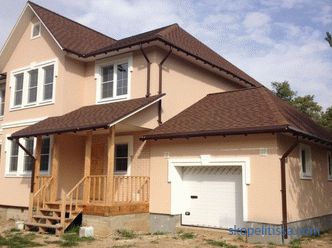
-
Wet technology "facade . For work various plaster solutions are used. Several layers create a monolithic structure; completes its layer of plaster, which is applied to the cleaned and prepared surface. The technology allows you to give your house a unique look, but it also has limitations - it cannot be used in the decoration of wooden buildings.
Materials used for insulation
Thermal insulation materials are designed for operation in various conditions. Whatever technology you choose to insulate the facade of the house, the cost of the work will be significantly influenced by the choice of the heat insulator. To choose the right insulation, it is important to understand what properties it has; at the same time pay attention to the following features:
-
Ability to retain heat . There are two types of insulation materials: reflective and preventing. Reflective insulation directs heat (in the form of infrared radiation) back to the housing. Preventing materials are characterized by low thermal conductivity; they provide insulation, making it difficult for heat to escape. The lower the thermal conductivity, the better the material retains heat.
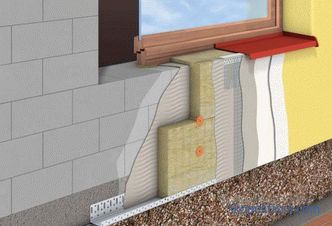
-
Water absorption . The ability to absorb (and give away) water vapor plays an important role in determining the lifetime of a heat insulator.
-
Weight of insulation . Before starting work, it is necessary to determine the load on the foundation and load-bearing walls.
-
Installation conditions . This criterion should not be neglected if the work will be carried out in winter (at low temperatures).
On our site you can find contacts of construction companies that offer home insulation services. You can directly communicate with representatives by visiting the low-rise country exhibition.
Polyfoam (polystyrene foam)
In a country house building material is very popular, which is easily explained by its attractive properties:
-
Low cost .Perhaps the main reason to conduct insulation of the facade of the house foam; the price of the material allows you to do this with minimal investment.
-
Easy installation . Very lightweight material, which makes it easy to transport, install and mount. After the foam is fixed, a reinforcing mesh is fixed on top, then a layer of plaster is applied (if necessary, additionally primed and painted).
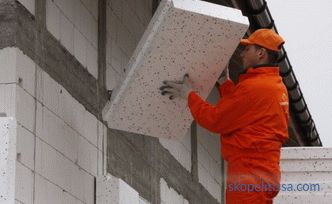
-
High heat and sound insulation properties .
-
Physical parameters . Styrofoam has a low water absorption, steam and air permeability, biological stability.
From the minuses of the material it is possible to distinguish its granular structure, which is easily destroyed by mechanical action and under the action of ultraviolet radiation. Foam refers to substances with high flammability and is able to do from a blowtorch or match flame. Errors made during installation can cause condensation to accumulate, which will inevitably start the process of mold formation.
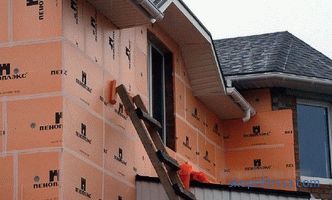
On our site you can find contacts of construction companies that offer the service of reconstruction and rebuilding of houses. You can directly communicate with representatives by visiting the low-rise country exhibition.
Expanded polystyrene (extruded polystyrene, penoplex)
Synthetic material that differs from conventional foam in the production method and some properties. The owners of private houses often choose insulation of the facade of the house from the outside with polystyrene foam; the price of installation works is comparable to foam plastic insulation. The use of penoplex as thermal insulation allows its following advantages:
-
Low thermal conductivity and lightness . According to these indicators, the material exceeds the usual polystyrene foam.
-
Minimum water absorption . Incorrect installation will cause condensation to form. The arrangement of the ventilated facade is recommended; glue penoplex allowed only on the basement of the house, under the finish.
-
High compressive strength .
-
Disadvantage . The main problem is the high class of flammability with the release of toxic substances.
About choosing insulation for a country house in the following video:
Mineral wool
Mineral wool It refers to preventing insulants and, depending on the raw materials, is divided into three types: glass (made from glass melt), stone (product of rock melt) and slag (made from blast furnace slag). The main disadvantage is the need to thoroughly protect the wool from moisture - the insulating properties of the wet wool are greatly reduced. The materials have different structure and the following characteristics:
-
Glass wool . A good (durable and elastic) heat insulator in a wide temperature range (from -60 to + 300 ° С), which is quite enough for the needs of insulation. The main disadvantage is the fragility of the fibers - small fragments can cause itching on the skin, irritation of the lungs and eyes. In order not to harm health, glass wool is laid in overalls, respirator and protective glasses.
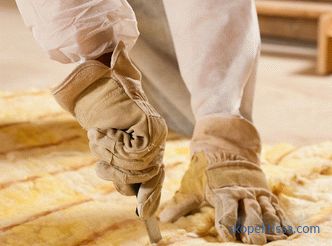
On our site you can find contacts of construction companies that offer extension service to existing homes. You can directly communicate with representatives by visiting the low-rise country exhibition.
-
Stone (basalt) wool . Material with good thermal insulation and vapor permeability. There are several types of stone wool with different levels of water resistance, affecting the durability of the material. Basalt wool, produced in slabs, is considered the best choice for facade insulation. It is environmentally friendly, safe in operation, does not change properties in a wide range of temperatures; when a critical temperature is reached, it does not burn, but melts.
-
Slag wool . Not suitable for outdoor insulation, because it absorbs water well and does not tolerate sudden temperature changes. The basis of slag - blast furnace slag does not always comply with environmental requirements.
About the nuances of mineral wool insulation in the following video:
Ecowool
There are two uses Ecowool (cellulose insulation). If it is necessary to carry out internal warming (ceiling, frame walls, floor), a dry technique is used - material granules are poured into the prepared cavity. External warming by the dry method is impossible; a wet method has been developed for this: ecowool is wetted with water, acquires viscosity and tackiness, and then sprayed automatically under pressure onto a prepared surface.
Ecowool's advantages include a good price-performance ratio, good vapor permeability and a high level of thermal insulation, which does not drop when wet. An important advantage of the material is the installation without seams, which prevents cold bridges from forming. The disadvantage is the restriction for use near the stove, fireplace or chimney. When wet application can not do without special equipment, after which it will take a couple of days to dry.
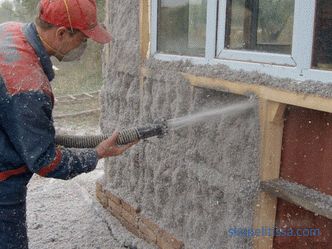
It may be interesting! In the article on the following link read about covering and insulation wooden house.
Polyurethane foam (PUF)
There are several types of polyurethane foam; for external insulation suitable closed-celled foam having the following properties:
-
Low thermal conductivity . Closed cells filled with gas, are the cause of the effective insulating properties of the material.
-
Water Resistance . PPU for external insulation does not need hydro and vapor insulation.
-
Durability . Service life reaches 20-30 years.
-
Fire Safety . PPU refers to low-flammable substances - in the manufacture of added flame retardants.
The following material features are considered disadvantages:
-
Extremely low vapor permeability . If the closed cell foam is selected for outdoor insulation, residential premises will need high-quality ventilation.
-
Increase in thermal conductivity with time . Carbon dioxide in closed cells is gradually replaced by air, the heat insulating properties deteriorate (to the level of open-cell insulation).
About the insulation of the PPU house in the following video:
-
Cost . PPU is one of the most expensive heat insulators.
Two methods of facade insulation using PPU are used. The first method is the insulation of PPU plates, a simple and universal technology that is no different from the installation of any plate materials. The second method is spraying polyurethane foam under high pressure, for which a gunning machine is used.
It can be interesting! In the article on the following link read about the insulation of the frame house outside under the siding.
Other types of insulation
In addition to materials intended for use on ventilated facades and polyurethane foam, other types of insulation can be identified, for example:
-
Plaster on insulation . Refers to the "wet" methods, because the work uses wet material. There is a significant choice of coatings on the market that can satisfy the most demanding designer. The facade turns out well warmed, beautiful and durable.
-
Warming panels . The panels not only improve the insulation, but also allow you to arrange the building in any architectural style. They can be mounted on any base - wood, brick, concrete.
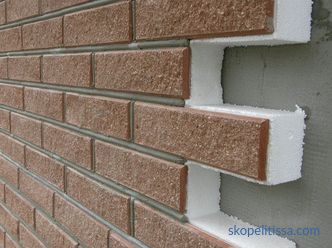
-
Insulation for Wet th "facade . Special plaster, the use of which reduces the heat loss at home. Insulation refers to the "wet" processes, characterized by long drying and long service life.
-
Warm tile (thermopanels) . A product of modern technology, a multi-layer system that can not only insulate housing and increase its service life, but also give the facade a new look.
What influences the cost of work
It is easiest to order works on facade insulation by calling or by leaving an application on the website of the relevant organization. After filing the application, the customer meets with an engineer who evaluates the facade and offers the best option for insulation and finishing. After coordination of the details, a work plan and estimate are drawn up. The final cost of facade insulation depends on the following parameters:
-
The type of heat insulation and finishing used.
-
Cost of the work being done.
About the choice of insulation for the wet facade in the following video:
-
Constructive features of the facade (for example, the presence of bay windows).
-
The area and general condition of the surface of the facade .
-
Scope of work (economy option or turnkey).
-
Weather factor . If the work is carried out in the winter, and the execution time is important for the customer, additional costs will be incurred for arranging a thermal circuit along the facade.
-
Cost of renting additional equipment (you may need a lift or scaffolding).
-
Costs for additional materials . You may need a contrabreshetka and special fasteners.
-
The object was removed from the implementing organization .Usually free delivery of materials is carried out within a certain area.
-
Accommodation of builders . You do not have to spend additional funds for the transportation of personnel, if there is an opportunity to place them on the object.
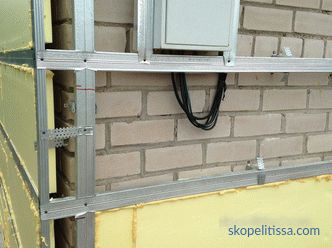
It might be interesting! In the article on The following link read about the types of insulation for mansard roofs.
Average prices for some work on insulation
The average cost for various types of work in Moscow and the region is as follows (without the cost of roughing and finishing materials, for m 2 ) :
-
Heat insulation mineral wool or polystyrene foam . From 380-400 rubles.
-
Reinforcement of the facade with mesh and glue. From 400-430 rubles.
-
Installation of plastering mesh . From 190-210 rubles.
-
Putting decorative plaster (bark beetle). From 380-400 rubles.
-
Facade painting on decorative plaster. From 130-150 rubles.
-
Plaster on a complex facade (thickness up to 30 mm). From 480-500 rubles.
-
Facade plaster (thickness over 30 mm). From 600 rub.
-
Insulation by spraying polyurethane foam . From 500-550 rubles.
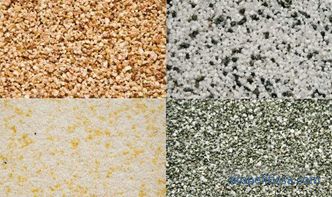
-
Installation of insulation (expanded polystyrene) on glue, including doweling. From 500-540 rubles.
-
Installation of reinforcing mesh . From 400-440 rubles.
-
Decorative plaster followed by painting. From 430-450 rubles.
The cost of some turnkey works takes the following form:
-
Facing with thermopanels with clinker tiles. From 850-1000 rubles.
-
Wet facade device (insulation with a decorative protective plaster layer). From 1200-1600 rubles. , depending on the insulation.
-
Warming by plate material (with a thin plaster layer). From 1000-1250 rubles.
-
Hinged ventilation facade with insulation and cladding with fiber cement plates . From 1500 rub.
-
Hinged ventilation facade with insulation and facing with ceramic granite . From 1650 rub.

It might be interesting! In the article Follow this link to read about the home of the dancing light in Arizona.
Conclusion
Up to 40-45% of heat is lost through non-insulated walls. Timely insulation of the facade helps to significantly reduce heat transfer and reduce costs during the heating season. It is especially pleasant that, in addition to the main task, it is possible to solve an additional one: to update the appearance of a country house. Choosing one or another method of insulation, you should not save on auxiliary materials - their quality affects the service life of the facade insulation.
